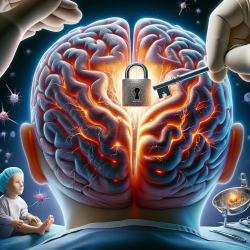Introduction
The field of autism spectrum disorders (ASD) is continually evolving, with research providing new insights into the underlying mechanisms and potential interventions. A recent study, "Optimizing the phenotyping of rodent ASD models," offers valuable data-driven insights that can enhance the skills of practitioners working with children with ASD. By understanding the neurobiological phenotypes associated with high-risk autism genes, practitioners can refine their approaches and contribute to better outcomes for children.
Key Findings from the Research
The study conducted an enrichment analysis of mouse and human neurobiological phenotypes linked to high-risk autism genes. The findings revealed four primary classes of neurobiological phenotypes:
- Changes in brain and neuronal morphology
- Electrophysiological changes
- Neurological changes
- Higher-order behavioral changes
These findings suggest that morphological changes can be quantitatively measured and widely adopted in ASD models to understand cellular and network changes. Additionally, the study highlights that electrophysiological changes differ across different genes, challenging the excitation/inhibition imbalance hypothesis for ASD.
Implications for Practitioners
Practitioners can leverage these insights to enhance their understanding and interventions in ASD. Here are some practical applications:
- Focus on Morphology: Understanding changes in brain and neuronal morphology can guide interventions that target cellular and network changes in children with ASD.
- Electrophysiological Insights: Recognizing the diverse electrophysiological changes can help practitioners tailor interventions to address specific neurological deficits.
- Behavioral Assessment: The study emphasizes the importance of neurological changes over higher-order behavioral changes, suggesting a broader approach to behavioral assessment and intervention.
Encouraging Further Research
The research underscores the importance of a broad neurobiological approach to phenotyping ASD models. Practitioners are encouraged to delve deeper into the study's findings and consider conducting further research in the following areas:
- Exploring the impact of specific ASD genes on brain morphology and function.
- Investigating the role of electrophysiological changes in ASD and their implications for therapy.
- Assessing the effectiveness of interventions targeting neurological changes in children with ASD.
Conclusion
By integrating the insights from this research into their practice, speech-language pathologists and other practitioners can enhance their understanding of ASD and contribute to improved outcomes for children. The study provides a robust framework for exploring the neurobiological underpinnings of ASD and encourages a data-driven approach to intervention.
To read the original research paper, please follow this link: Optimizing the phenotyping of rodent ASD models: enrichment analysis of mouse and human neurobiological phenotypes associated with high-risk autism genes identifies morphological, electrophysiological, neurological, and behavioral features.










